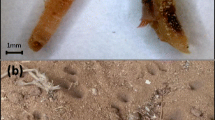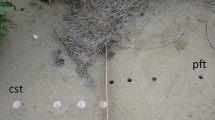Abstract
Antlion larvae are sand-dwelling insect predators, which ambush small arthropod prey while buried in the sand. In some species, the larvae construct conical pits and are considered as sit-and-wait predators which seldom relocate while in other species, they ambush prey without a pit but change their ambush site much more frequently (i.e., sit-and-pursue predators). The ability of antlion larvae to evade some of their predators which hunt them on the sand surface is strongly constrained by the degree of sand stabilization or by sand depth. We studied the effect of predator presence, predator type (active predatory beetle vs. sit-and-pursue wolf spider), and sand depth (shallow vs. deep sand) on the behavioral response of the pit building Myrmeleon hyalinus larvae and the sit-and-pursue Lopezus fedtschenkoi larvae. Predator presence had a negative effect on both antlion species activity. The sit-and-wait M. hyalinus larvae showed reduced pit-building activity, whereas the sit-and-pursue L. fedtschenkoi larvae decreased relocation activity. The proportion of relocating M. hyalinus was negatively affected by sand depth, whereas L. fedtschenkoi was negatively affected also by the predator type. Specifically, the proportion of individual L. fedtschenkoi that relocated in deeper sand was lower when facing the active predator rather than the sit-and-pursue predator. The proportion of M. hyalinus which constructed pits decreased in the presence of a predator, but this pattern was stronger when exposed to the active predator. We suggest that these differences between the two antlion species are strongly linked to their distinct foraging modes and to the foraging mode of their predators.



Similar content being viewed by others
References
Abrams P, Menge BA, Mittelbach GG, Spiller D, Yodzis P (1996) The role of indirect effects in food webs. In: Polis GA, Winemiller KO (eds) Food webs: integration of patterns & dynamics. Kluwer, Boston, pp 371–395
Agrawal AA (2001) Phenotypic plasticity in the interactions and evolution of species. Science 294:321–326
Brown JS (1988) Prey use as an indicator of habitat preference, predation risk, and competition. Behav Ecol Sociobiol 22:37–47
Brown JS, Kotler BP (2004) Hazardous duty pay and the foraging cost of predation. Ecol Lett 7:999–1014
Cain ML (1987) Prey capture behavior and diel movement of Brachynemurus (Neuroptera: Myrmeleontidae) antlion larvae in south central Florida. Fla Entomol 70:397–400
Caswell H (2001) Matrix population models, 2nd edn. Sinauer, Sunderland
Greef JM, Whiting MJ (2000) Foraging-mode plasticity in the lizard Platysaurus broadleyei. Herpetologica 56:402–407
Griffiths G (1992) Interference competition in ant-lion (Macroleon quinquemaculatus) larvae. Ecol Entomol 17:219–226
Huey RB, Pianka ER (1981) Ecological consequences of foraging mode. Ecology 62:991–999
Johnson JB, Omland KS (2004) Model selection in ecology and evolution. Trends Ecol Evol 19:101–108
Krupa JJ, Sih A (1998) Fishing spiders, green sunfish, and a stream-dwelling water strider: male-female conflict and prey responses to single versus multiple predator environments. Oecologia 117:258–265
Lima SL (1998a) Stress and decision making under the risk of predation: recent developments from behavioral, reproductive, and ecological perspectives. Adv Study Behav 27:215–290
Lima SL (1998b) Non lethal effects in the ecology of predator-prey interactions. BioScience 48:25–34
McPeek MA, Peckarsky BL (1998) Life histories and the strengths of species interactions: combining mortality, growth, and fecundity effects. Ecology 79:867–879
Relyea RA, Auld JR (2004) Having the guts to compete: how intestinal plasticity explains costs of inducible defences. Ecol Lett 7:869–875
Rodriguez-Prieto I, Fernandez-Juricic E, Martin J (2006) Anti-predator behavioral responses of mosquito pupae to aerial predation risk. J Insect Behav 19:373–381
Scharf I, Ovadia O (2006) Factors influencing site abandonment and site selection in a sit-and-wait predator: a review of pit-building antlion larvae. J Insect Behav 19:197–218
Scharf I, Nulman E, Ovadia O, Bouskila A (2006) Efficiency evaluation of two competing foraging modes under different conditions. Am Nat 168:350–357
Schmitz OJ, Suttle KB (2001) Effects of top predator species on direct and indirect interactions in a food web. Ecology 82:2072–2081
Schmitz OJ, Krivan V, Ovadia O (2004) Trophic cascades: the primacy of trait-mediated indirect interactions. Ecol Lett 7:153–163
Sih A, Kats LB (1991) Effects of refuge availability on the responses of salamander larvae to chemical cues from predatory green sunfish. Anim Behav 42:330–332
Sih A, Englund G, Wooster D (1998) Emergent impacts of multiple predators on prey. Trends Ecol Evol 13:350–355
Simon D (1988) Ant-lions (Neuroptera: Myrmeleontidae) of the coastal plain: systematical, ecological, and zoogeographical aspects with emphasis on the coexistence of a species guild of the unstable dunes, PhD thesis. Tel-Aviv University, Israel
Sokal RR, Rohlf FJ (1995) Biometry, 3rd edn. Freeman, NY
Stamp NE, Bowers MD (1991) Indirect effect on survivorship due to presence of invertebrate predators. Oecologia 88:325–330
Templeton CN, Shriner WM (2004) Multiple selection pressures influence Trinidadian guppy (Poecilia reticulate) antipredator behavior. Behav Ecol 4:673–678
Werner EE, Anholt BR (1993) Ecological consequences of the trade-off between growth and mortality rates mediated by foraging activity. Am Nat 142:242–272
Werner EE, Peacor SD (2003) A review of trait-mediated interactions in ecological communities. Ecology 84:1083–1100
Wooster D, Sih A (1995) A review of the drift and activity responses of stream prey to predator presence. Oikos 73:3–8
Acknowledgments
We would like to thank Matan Golan for his help in the field. The research was supported by the Israel Science Foundation Grant 1084/05 (to O. O.).
Author information
Authors and Affiliations
Corresponding author
Additional information
Communicated by: D. Gwynne
Reut Loria and Inon Scharf contributed equally to the paper.
Rights and permissions
About this article
Cite this article
Loria, R., Scharf, I., Subach, A. et al. The interplay between foraging mode, habitat structure, and predator presence in antlions. Behav Ecol Sociobiol 62, 1185–1192 (2008). https://doi.org/10.1007/s00265-008-0547-y
Received:
Revised:
Accepted:
Published:
Issue Date:
DOI: https://doi.org/10.1007/s00265-008-0547-y




